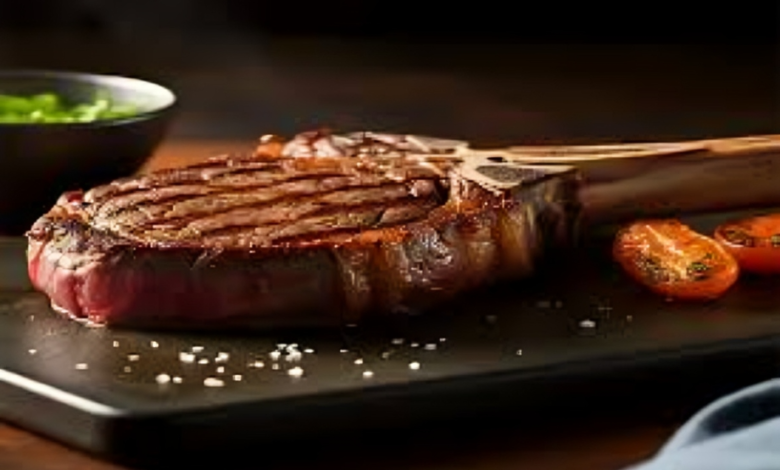Perfecting the Medium Rare Steak Temp A Comprehensive Guide

Cooking a steak to perfection, especially to the coveted medium rare, is a culinary skill worth mastering. Achieving the right internal temperature for Medium Rare Steak Temp brings out the full flavor of the meat while maintaining its tenderness and juiciness. In this guide, we’ll explore everything you need to know about the ideal Medium Rare Steak Temp, the techniques involved, and some helpful tips to ensure you get it right every time.
Why Medium Rare is the Most Popular Steak Temperature
Medium rare is considered by many chefs and steak lovers to be the “sweet spot” of doneness. This temperature:
- Retains Juiciness: Medium Rare Steak Temp retains the meat’s natural juices, giving it a succulent texture and rich flavor.
- Enhances Flavor: Cooking to medium rare allows the steak’s natural marbling and fats to melt and infuse the meat, creating a rich taste without drying it out.
- Tender Texture: The proteins in the steak have barely begun to contract, resulting in a tender, buttery texture that’s easy to chew.
For a Medium Rare Steak Temp, the internal temperature should be around 130-135°F (54-57°C). At this temperature, the meat will appear pink in the center, with the outer edges slightly browned due to the Maillard reaction, which enhances flavor.
Achieving Medium Rare: Step-by-Step Guide
Step 1: Choose the Right Cut
For the best medium rare steak experience, start with the right cut. Some of the most popular cuts include:
- Ribeye: Known for its marbling and flavor, ribeye is tender and rich, making it a great choice for medium rare.
- Filet Mignon: A lean cut, filet mignon is prized for its tenderness. While it lacks the marbling of a ribeye, its texture shines at medium rare.
- New York Strip: This cut offers a balance between tenderness and flavor, with moderate marbling that cooks well to medium rare.
Step 2: Let the Steak Reach Room Temperature
Before cooking, let the steak sit at room temperature for 20-30 minutes. This helps it cook more evenly and reduces the risk of overcooking the outer layers before the center reaches medium rare.
Step 3: Season Generously
Season your steak with salt and pepper, but don’t be afraid to get creative. Salt helps draw moisture to the surface, forming a nice crust when seared, while other seasonings like garlic powder, rosemary, or thyme can enhance the flavor.
Step 4: Preheat the Pan or Grill
For a perfect Medium Rare Steak Temp, use a high-heat method such as:
- Cast Iron Skillet: This retains heat well and allows for even cooking.
- Grill: A grill imparts a smoky flavor, making it ideal for thicker cuts of steak.
- Sous Vide: While unconventional, sous vide ensures an exact temperature by cooking the steak in a water bath, then finishing it with a quick sear.
Ensure the skillet or grill is preheated to high heat, ideally around 400°F, to create the Maillard reaction that forms a beautiful crust.
Step 5: Cook and Monitor the Temperature
To achieve medium rare:
- Cook the steak for 3-5 minutes per side depending on the thickness. For example, a 1-inch-thick steak typically needs 4 minutes per side for medium rare on a high-heat skillet.
- Flip only once. This prevents moisture loss and helps form a more even crust.
- Use a Meat Thermometer: Insert the thermometer into the thickest part of the steak, avoiding the fat, to ensure an accurate reading. For medium rare, aim for 130-135°F (54-57°C). If using a thermometer isn’t an option, you can perform a finger test, pressing the meat lightly to assess its firmness.
Step 6: Let the Steak Rest
Resting the steak is essential to achieving the best medium rare result. Transfer it to a plate and tent with aluminum foil, letting it rest for about 5 minutes. This allows the juices to redistribute, ensuring each bite is juicy and flavorful.
Step 7: Slice and Serve
Cut the steak against the grain to maximize tenderness. This technique shortens the muscle fibers, making each slice more tender and flavorful.
Techniques for Cooking Medium Rare Steak Temp
1. Pan-Searing
This technique involves searing the steak on a stovetop in a heavy skillet, like cast iron. Add a small amount of oil with a high smoke point (like canola or avocado oil). Sear each side for 3-5 minutes, depending on thickness, then check the temperature.
2. Grilling
Grilling a medium rare steak adds a smoky, charred flavor. Place the steak on a preheated grill over high heat, searing each side for 3-4 minutes. Use indirect heat if the steak is thick to avoid burning the exterior.
3. Reverse Searing
For an even cook, try reverse searing:
- Preheat the oven to a low temperature (250°F).
- Place the steak in the oven until it reaches an internal temperature of 120°F.
- Transfer to a hot skillet or grill to quickly sear each side, bringing it up to 130-135°F for medium rare.
4. Sous Vide Method
With sous vide, set the water bath to 130°F and cook the steak for 1-2 hours. Afterward, sear the steak in a hot pan for 1-2 minutes per side for a perfect crust without overcooking the interior.
Tips for the Perfect Medium Rare Steak
- Use a Meat Thermometer: A thermometer is the most reliable tool for ensuring you hit that medium rare range of 130-135°F.
- Mind the Thickness: Thicker steaks (1.5 to 2 inches) cook more evenly and allow more control over the doneness.
- Avoid Overcrowding: When cooking multiple steaks, ensure each one has space. Overcrowding the pan reduces heat, leading to steaming rather than searing.
- Baste with Butter: In the final moments of cooking, add a pat of butter, along with herbs like rosemary and thyme, to the pan. Spoon the melted butter over the steak to enhance flavor.
- Experiment with Marinades: While salt and pepper are traditional, marinades can add layers of flavor. Try a simple blend of olive oil, garlic, and soy sauce for an added punch.
Common Mistakes to Avoid
- Not Letting the Steak Rest: Slicing into a hot steak releases the juices, leading to a drier texture.
- Cooking Straight from the Fridge: Cold meat cooks unevenly and can lead to a raw center or overcooked exterior.
- Overflipping the Steak: Flipping multiple times interrupts the searing process and can make the steak tougher.
Frequently Asked Questions
1. What’s the difference between rare and medium rare?
- Rare steak has an internal temperature of 120-125°F, with a cool, red center, whereas medium rare is slightly warmer at 130-135°F, providing a warm pink center.
2. Is it safe to eat medium rare steak?
- Yes, it’s safe to eat beef at medium rare temperatures, as long as it’s been stored and handled properly.
3. How do I know my steak is medium rare without a thermometer?
- The finger test is a simple way: press your thumb and middle finger together, and feel the fleshy part of your thumb. This resembles the feel of a medium rare steak.
Final Thoughts
Mastering the art of cooking a Medium Rare Steak Temp takes practice, but the payoff is well worth it. A perfectly cooked Medium Rare Steak Temp embodies the best qualities of beef—tender, juicy, and flavorful. Whether you prefer to pan-sear, grill, or use a sous vide method, following these steps will help you achieve the ideal medium rare temperature every time. Armed with a good meat thermometer, a reliable cooking method, and these tips, you’ll be impressing friends and family with your steak-cooking skills in no time.
